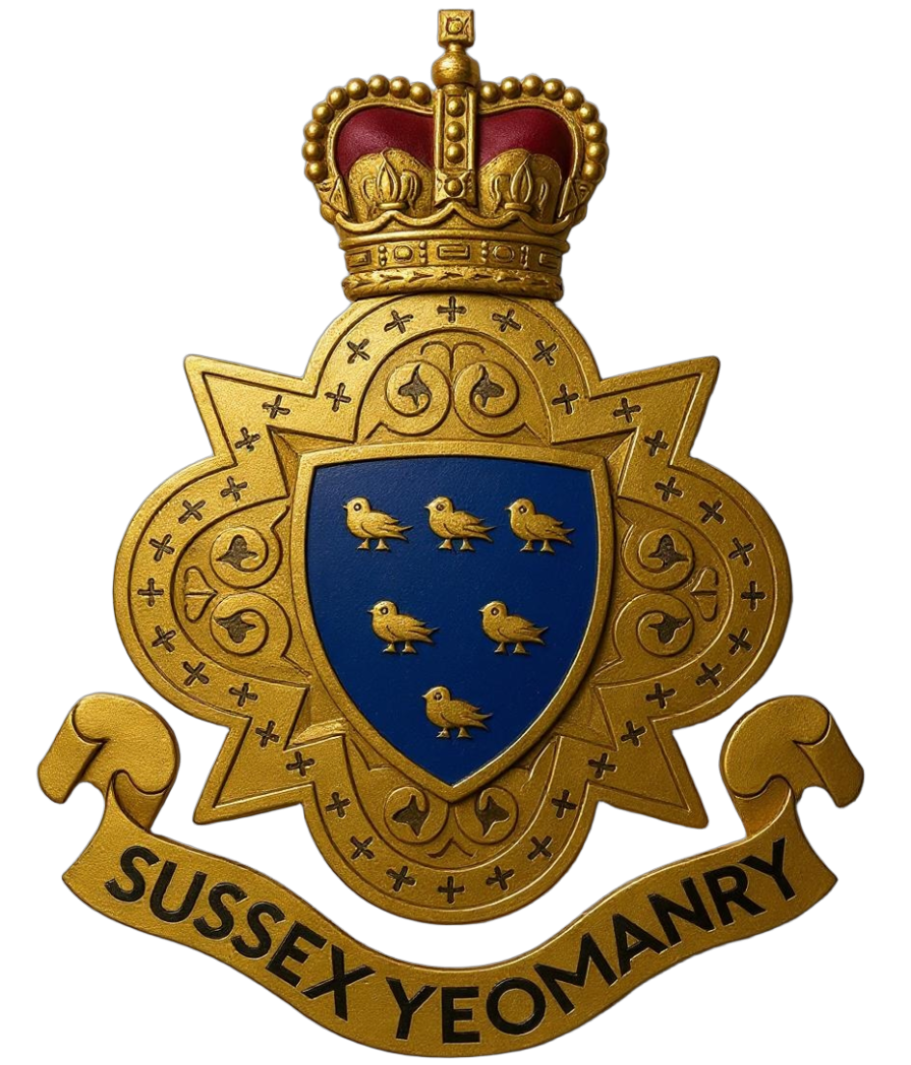1947 and beyond
Reshaped and Remembered: The Sussex Yeomanry After the War
The Territorial Army was reformed in 1947. Three distinct factors would influence its initial structure, and the subsequent refining of the organisation during the following decades.
- Although the United Kingdom was one of the victors of World War 2, its ruined economy would take many years to recover. This period of austerity necessitated the rationing of meat, milk, sugar, clothes, petrol and coal, and although gradually phased out, rationing continued until 1958. During 1948, petrol rationing capped private motor vehicle usage at about 90 miles per month. However, only 5.1% of the adult population could afford to own a car. Drill halls for Territorial soldiers to parade at needed to be local, ideally within walking or cycling distance, or perhaps a short bus ride, from their homes. Existing, pre-war drill halls were re-established in every town and city.
- In January 1949, National Service was reintroduced, requiring all healthy males between 18 and 30 to serve in the armed forces for eighteen months (extended to two years in 1950 during the Korean War). These conscripted soldiers also remained on the reserve for an additional four years and could be recalled to their units for up to 20 days (on three occasions) during these four years of reserve commitment. National Service ended gradually, being phased out from 1957, with the last conscripted servicemen leaving the armed forces in May 1963.
- Lasting from 1947 until the dissolution of the Soviet Union in 1991, the ‘Cold War’ was a period of geo-political tension between the United States and the Soviet Union and their respective allies. The term ‘cold war’ is used because the conflict never turned ‘hot’ with a direct global, and likely nuclear, conflict between the two superpowers, but remained ‘cold’ with each side supporting opposing factions in multiple regional or ‘proxy’ wars, such as the Malaya Emergency (1948–1960), Korean War (1950–53), Suez Crisis (1956), Congo Crisis (1960–65), Vietnam War (1965–73), Angolan Civil War (1974–2002), the Russian occupation of Afghanistan (1979–89) and many more. Additionally, both sides tried to exert their ideological and economic influence over an arms race (both conventional and nuclear), the space ‘race’ to see whose technology could put a man into space, and then onto the moon first, as well as in espionage, propaganda, trade embargoes, and sporting boycotts.
The Sussex Yeomanry
When the Territorial Army reformed in April 1947, the Sussex Yeomanry became 344 (Sussex Yeomanry) Light Anti-Aircraft Regiment, Royal Artillery, despite having no previous experience in an anti-aircraft (AA) role. Equipped with wartime 40mm Bofors guns, the two batteries were formed in the pre-war 389 and 390 Bty locations of Brighton and Chichester.
During 1950, the Brighton-based, 605 Heavy AA Regiment was absorbed into 344 Regiment.
With the disbandment of Anti-Aircraft Command in March 1955, all of the remaining anti-aircraft units of the Royal Artillery within Sussex were merged into a single entity.
This new formation, 258 (Sussex Yeomanry) Light Anti-Aircraft Regiment, Royal Artillery, had its headquarters and P Bty in Brighton (previously 344 Light AA Regt, RA), Q Bty in Chichester (also part of 344 Light AA Regt RA), R Bty in Worthing (previously 313 Heavy AA Regt & 641 Heavy AA Regt) and S Bty in Eastbourne (Previously 258 Heavy AA Regt).
Six years later, in May 1961, 258 (Sussex Yeomanry) LAA regiment would merge with 257 (County of Sussex) Field Regiment Royal Artillery, forming a single, county-wide field artillery regiment equipped with towed 25-pounders.
257 (Sussex Yeomanry) Field Regiment Royal Artillery had its headquarters in Brighton, P Bty in Bexhill and Eastbourne, Q Bty in Haywards Heath and Crawley, and R Bty in Worthing.
The Defence White Paper of 1966 converted the remaining Territorial Army units into the Territorial and Army Volunteer Reserve (TAVR) during 1967, abolishing existing regimental structures and categorising units into their deployable status.
Designated as TAVR II – NATO Deployable, a new battery equipped with the BL 5.5inch Gun would form in Brighton as the senior battery of the senior regiment within the Royal Artillery’s new six-regiment order-of-battle.
200 (Sussex Yeomanry) Field Battery, Royal Artillery (Volunteers), was based at Dyke Road, Brighton and was part of 100 (Yeomanry) Field Regiment, Royal Artillery. Re-equipped with the L118 105mm Light Gun in 1980, 200 Bty would continue in this role throughout the remainder of the Cold War, deploying to Germany in the major NATO Exercises that define this era (Ex Lionheart in September 1984 was the largest overseas deployment of British Forces since World War 2, and Ex Keystone in October 1987.)
With the collapse of the Soviet Union in 1991 a restructuring of the British Army’s Reserve capability inevitably followed. Known as ‘Options for Change,’ in 1992 200 Bty RA was placed into suspended animation and a new unit, 127 (Sussex Yeomanry) Field Squadron of the Corps of Royal Engineers was formed as a component of 78 (Fortress) Engineer Regiment RE.
Unfortunately, the Strategic Defence Review of 1998 disbanded 78 (Fortress) Regiment RE during 1999 and with it, the Sussex Yeomanry.
